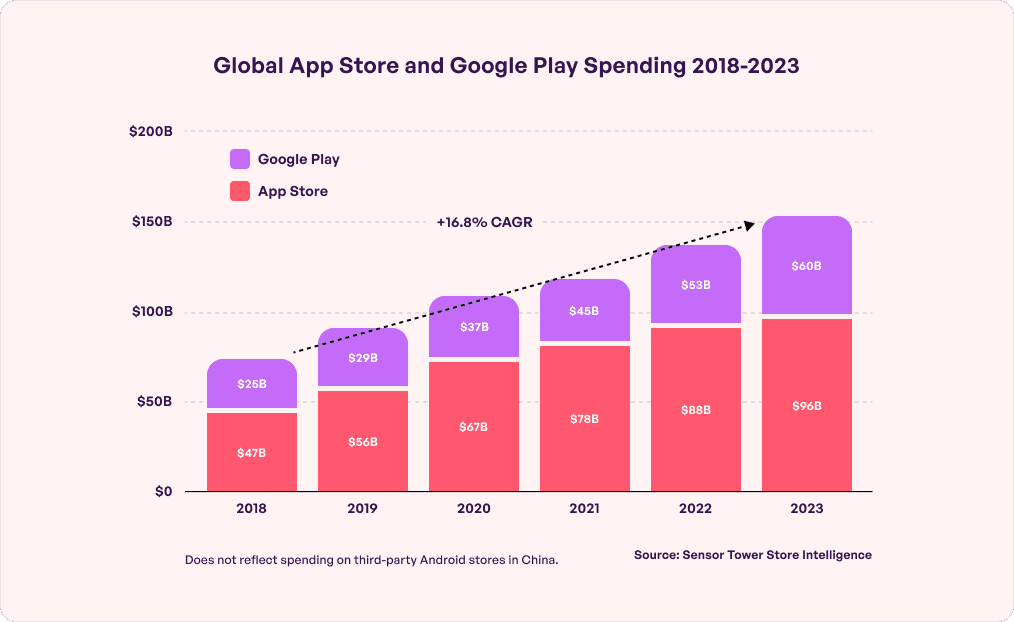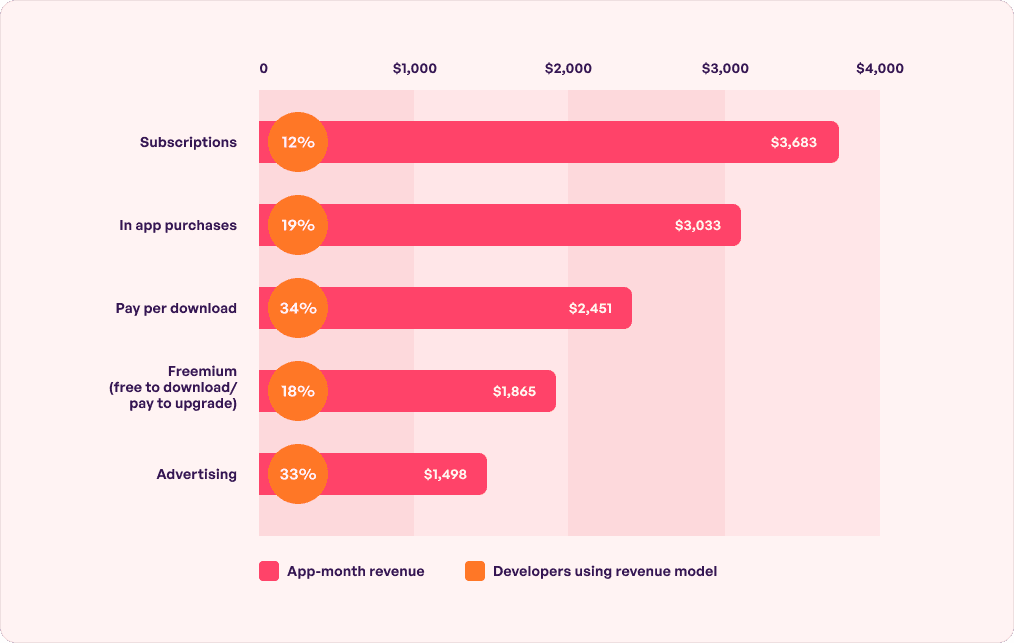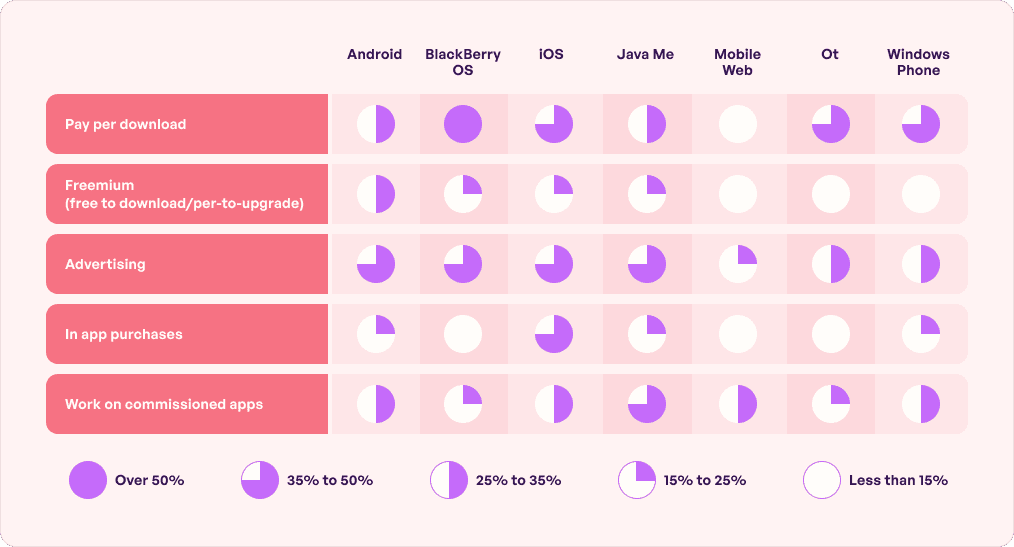If there is one thing that is keeping the charm of entering a heavily competitive market like mobile application intact for entrepreneurs, it is the fact that there is evident proof of monetary profit. A SensorTower report states that consumer spending in mobile apps through App Store and Play Store will reach $171 billion globally in 2024 – a number that is set to grow with time.
Noting the high monetary ROI at stake, entrepreneurs have started looking for different mobile app monetization models to incorporate in their applications.
In this article, we are going to explore the multiple types of app revenue models and which strategy would fit which type of business.
Now before we reach that stage, let’s dive into some present-day app revenue statistics highlighting the state of app owners’ earnings.
Table of contents
Top Mobile App Monetization Statistics

- 38.5k apps in the Google Play Store are priced at less than a dollar. 26.6 thousand are priced between 1 and 2 dollars, and 2300 are priced in the range of 9 and 10 dollars. [Statista]
- 1.6 million apps in the App Store are priced lower than a dollar. 2800 apps are priced between 9 and 10 dollars. [Statista]
- Paid apps are expected to generate a maximum of $7 billion USD from app purchases by 2026. [Statista]
- 3% of apps globally are monetized by being paid apps. 36% through ads, and 4% through in-app purchases. [Statista]
The way to get your business become a part of these statistics, it is critical to implement the best mobile app revenue models. Let us look into them.
The Best Mobile App Revenue Models
Depending on your application type, there are a number of mobile app monetization strategies you can choose from. The decision, however, should be taken from the early stages of the digital product development process, since the choice would affect the app’s structure, user experience, and feature sets.

1. In-App Advertising
One of the most commonly used strategies, the app advertising revenue model, is one that you also must have come across in your app-using journey. This is where ads are displayed to the users after relevant intervals and the moment users click on the ad, the app owners get a revenue hit from the ad company.
The different ad formats that the app owners can choose from include –
- Banner ads
- Full-screen or Interstitial ads
- Reward ads
- Affiliate ads
- Video ads
- Playable ads
2. In-App Purchases
The in-app purchases model is probably one of the most used strategies in the digital sphere. The idea behind it is that the users buy some elements of the app in order to move further or get a better, exclusive experience.
Although extremely common, it can be difficult to manage in the long run, especially because it is difficult to keep offering new features or experiences to the users.
Which apps benefit most from the model: Gaming, Fitness, and Relationship-based apps.
3. Subscription
Subscription or Freemium app revenue model is one where the users get free access to the application with some features or content locked for in-app purchases. Some of the top benefits that come at the back of this model include –
- A ‘try before you buy’ approach enables users to try the application without any upfront costs.
- Lowered customer acquisition cost because of easy in-app entry.
- A predictable revenue stream.
Which apps does the freemium model work best for: All media-heavy apps like OTT, Music apps, Courses apps, and Dating apps.
4. Paid Apps
This revenue model works in a way that the users pay for the app at the time of download itself. While being one of the top used models since the time of app sector’s inception, paid apps are slowly losing their place to freemium or in-app purchase models because of the inability to constantly give ROI-friendly features and experience.
It usually works for applications that have established their name in the industry or have come up with a unique solution to a mass-level problem.
5. Hybrid Monetization Model
This is nothing but a combination of multiple app revenue models. Based on the business model, app companies can choose to maximize their profits by applying more than one model.
The most common combination when it comes to hybrid monetization is that of in app advertising revenue model, in-app purchase revenue model, and data monetization revenue model.
Which apps can benefit from this: While any application can benefit from combining two or more models, this is most commonly seen in practice in gaming applications.
6. Partnership/Sponsorship Model
Brand sponsorships can be an efficient way to get app revenue. Here the app owners partner with complementary brands by offering them exposure within the application. For every booking or purchase the user makes on the sponsored brand, the application gets a commission.
The key here is to ensure that the sponsorship is relevant to the app’s audience as only then it would be a win-win situation for both.
Which apps work best for this model: Super apps, Finance, and Travel.
7. Affiliate Marketing
In this app monetization model, you earn commission by marketing or selling other company’s offerings within your application. When you direct the traffic from your application to the affiliate partners’, you get a percentage of the subscription or purchase that the users make on their platform.
The way to approach this is by researching programs around your niche and then joining them as a partner. Some of the famous platforms you can do this with are – Rakuten Marketing, CJ Affiliate, and Impact.
Apps that resonate best with this model: eCommerce, SaaS, Travel and hospitality.
8. Data Monetization
Under this model, businesses sell users data to third parties in return of revenue. While we know how controversial and unethical data monetization strategy sounds, the model is legal if you have explained the usage, type of data, and frequency of data collection to the users.
The only catch here is that users have, over time, become very conscious of how their data is used and shared, so if you fail to mention it to them, it may lead to severe financial and legal consequences.
Amidst so many app revenue models already in the market and a number of others emerging on a frequent basis, it can become difficult for entrepreneurs to choose the best approach. Let us look into the how next.
How to Choose the Best App Revenue Models?
There are a number of elements that help select the best revenue model for an app business to go with. Here are the top ones.
- Competitor analysis
- App’s usage patterns
- Availability of natural add-ons
- Target audience
In addition to this, the app domain is also witnessing a trend where the returns of revenue models are getting affected by the platform your app is active on. Have a look.

Hopefully, at this point in the article, you would have gotten clarity on what to ask of your mobile app development company in terms of the right monetization technique. As we conclude the piece, let us look into the different strategies that would make the journey of implementing ads profitable.
Best Strategies for App Revenue Model Integration
App monetization should be directly aligned with the user experience – this is the one golden rule that will greatly impact your app revenue generation efforts. Here are some ways to support the process – ones that we, at Simublade, always suggest to our clients.
- Understand what makes your users pay for a product, service, or experience by looking into your competitors or running extensive market research.
- Map out your user’s journey to know the areas in which they are most likely to convert into paying customers.
- Test pricing carefully by offering tiered options. A price that is too high or too low can backfire.
- Offer the option to not see ads or prompts to become a premium member.
- Have enough items of value to make users appreciate your application and pay for the service.
- Keep an eye out on metrics like LTV, churn rate, conversion rate, etc. to know which model is working for you.
FAQs
Q. How much do apps generate in revenue?
A. There is no bar around how much an application can generate on the back of a well-planned app monetization strategy built on a solid user experience study. The sign of this is that the revenue count of both the app stores combined is set to reach $171 billion globally.
Q. Which is the best monetization model for my app?
A. There is no one answer to this. The ideal model will depend on your user base, app usage patterns, competitors, frequency of new experiences and features you can add, etc.
Q. How does an app generate revenue?
A. There are a number of ways an application can generate revenue. Here are the top options – In-app advertising, In-app purchases, Subscription, Paid apps, Hybrid monetization model, Partnership/sponsorship model, Affiliate marketing, and Data monetization.




